
LIKE FIRE ACROSS THE GALAXY
In the blink of an eye, it seemed, the galaxy was embroiled in a full-scale galactic war. The Separatist Alliance congealed into the Confederacy of Independent Systems, a coalition of loosely aligned worlds united for war. It pooled its resources to purchase huge quantities of battle droids, creating a ready-to-deploy army. The Republic mobilized its newly activated clone forces and hurriedly brevetted the Knights of the Jedi Order into military commanders. After a massive engagement on the distant world of Geonosis, a planet beyond the Republic borders, war was once again a reality in the galaxy.
The sudden mining of hyperspace routes allowed the Separatists to encircle the Republic as the next stage of the conflict began. To better navigate past the cordon, the Republic struck up an alliance with the reigning Hutt kajidics of the Outer Rim Territories. War made strange bedfellows—a few decades before, the Republic’s Judiciary branch had launched a major public awareness campaign based on the threat posed by Hutt criminal activities. Such concerns were conveniently swept away when the Clone Wars turned the Hutts into allies, and the Hutts, as fit their nature, profited handsomely from such arrangements.
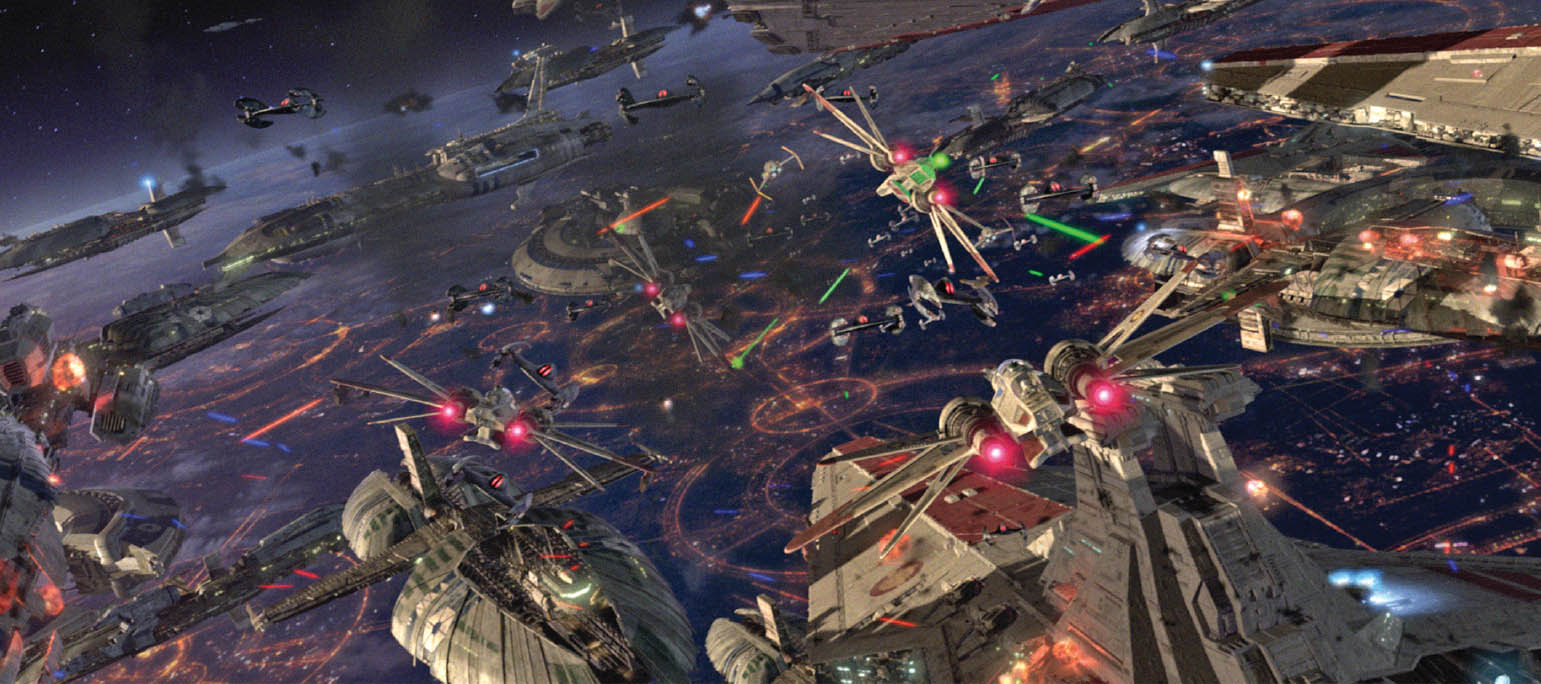
The Clone Wars did the unthinkable—it put the Core Worlds at risk. The insulated heart of the Republic had grown complacent in a sense of security and comfort. By war’s end, the encroaching fear of Separatist attack reshaped the galaxy.
History tells us now that the greatest benefactors of the conflict were the corporations that funded the battle on both sides. The Trade Federation, the Corporate Alliance, the Commerce Guild, the Techno Union, and the InterGalactic Banking Clan made noises about Republic loyalty (or at least staunch neutrality) all the while cutting deals with the Separatists for conquered land and assets. These corporations sold weapons and matériel to both sides of the war. When such treacherous collusion was exposed to Republic and Separatist citizens alike, artists amplified their efforts to vilify the rich titans of industry and commerce.
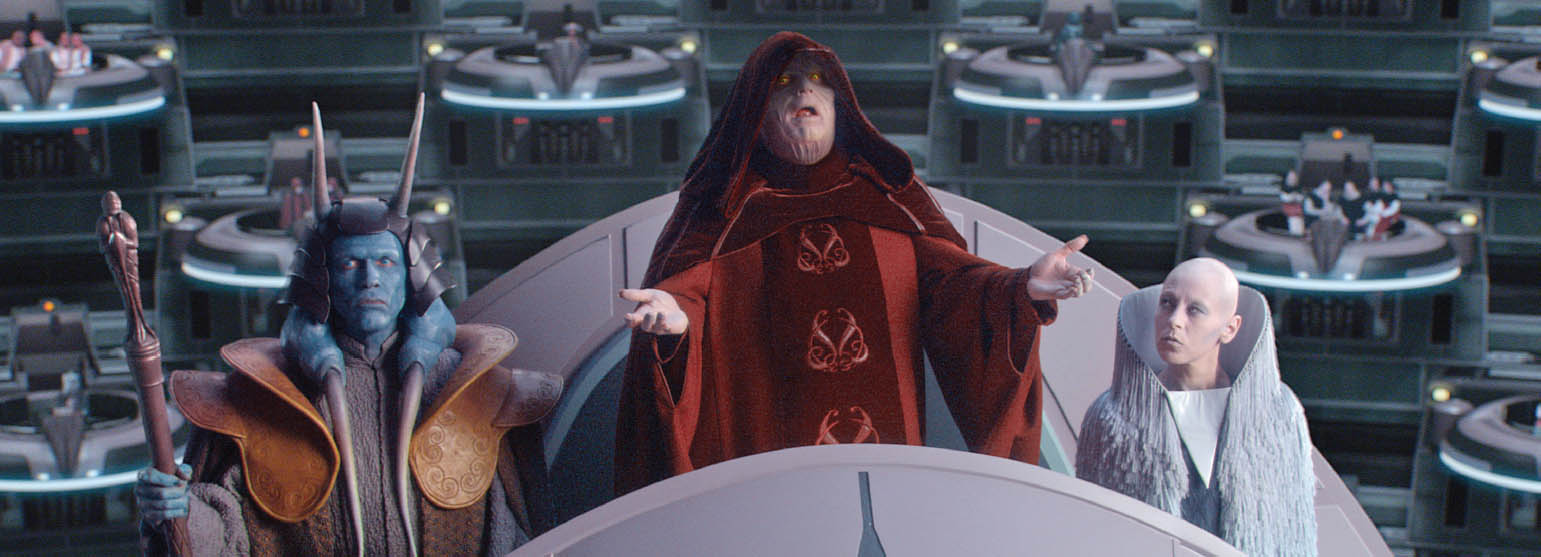
In this climate of dread and insecurity, Supreme Chancellor Palpatine promised reform. The Senate increasingly relinquished executive powers to him and his personally appointed advisors to better wage galactic war. This ceding of power culminated in Palpatine laying the blame for the carnage at the feet of the Jedi Order and its fellow conspirators in the Senate.
For the Republic, the war effort required a complex and far-reaching public support campaign to stir patriotism on the home front. Republic citizens were asked to buy war bonds, ration supplies, and curtail freedoms during this time of crisis. Chancellor Palpatine was routinely portrayed as a fatherly figure requiring help from his vast family to defend the Republic. Such an image made it easier to pass the emergency measures that gave Palpatine increased executive powers.
During the conflict, former independent states were challenged and courted by both sides in a bid to bolster resources and military strength. The Duchess Satine Kryze of Mandalore headed up a Council of Neutral Systems, more than 1,500 star systems that wanted no part in the war. Mandalore, home to many gifted artists, produced several works chastising both sides of the conflict while encouraging worlds to seek out true independence. However, these efforts faltered when Mandalore succumbed to its own internal conflict, and Satine Kryze was murdered by the shadowy forces of the Death Watch, a violent Mandalorian splinter group.
In Republic space, Count Dooku was branded as public enemy number one. The next greatest threat to Republic safety was General Grievous, the cyborg commander of the droid army. The Republic painted Grievous as a mechanical monstrosity—a description that played to deep-seated fears regarding droids. One by-product of the Clone Wars was an exacerbation of anti-droid sentiment in the galaxy. Once-useful automatons were branded as potential security threats, and combat droids were heavily regulated in Republic space.
The clone troopers, by contrast, were celebrated as heroes. Many Republic bulletins lauded the bravery of the “boys in white,” and Republic citizens were honored to billet clone troopers in their home during extended campaigns. The Kaminoans responsible for the creation of the clones were fast-tracked into Republic membership and given full Senatorial representation as a result of their industry. The need to keep clone supplies replenished caused a major reorganization of finances in the Republic, culminating in Supreme Chancellor Palpatine nationalizing the InterGalactic Banking Clan.
Absent from this hero-making were the Jedi Knights. Citizens who witnessed the Jedi in action were understandably in awe of their abilities, but it was the clone trooper who was the public face of the war effort. The mystic Jedi remained forever inscrutable to the Republic citizenry at large. To the Separatists, they were branded as hypocrites (thanks to firsthand criticism by Count Dooku). That they could so callously brandish a clone army—“slaves bred for war,” as Separatist propaganda proclaimed—did not speak well to their character, though few among the Separatists knew that the Jedi were given no choice in the matter.
After three long years of conflict, which included military strikes that reached the heart of the Core Worlds, public opinion soured on the war. More and more citizens saw the conflict as fruitless and demanded a negotiated settlement. It was during the height of this discontent that Chancellor Palpatine shocked the galaxy by exposing the Jedi Order as traitors. Despite some muted protests in the Senate, Palpatine easily spread this claim by reminding the galaxy that Dooku, the Republic’s greatest threat in a thousand years, was a former Jedi. When the Republic military destroyed both Count Dooku and General Grievous, the war was brought to an end.
To ensure such a war would never happen again, Palpatine re-formed the Republic as the First Galactic Empire. A war-weary galaxy was more than ready to erase the Jedi Order from the pages of history and turned instead to the battle-tested Imperial war machine for its salvation from chaos.
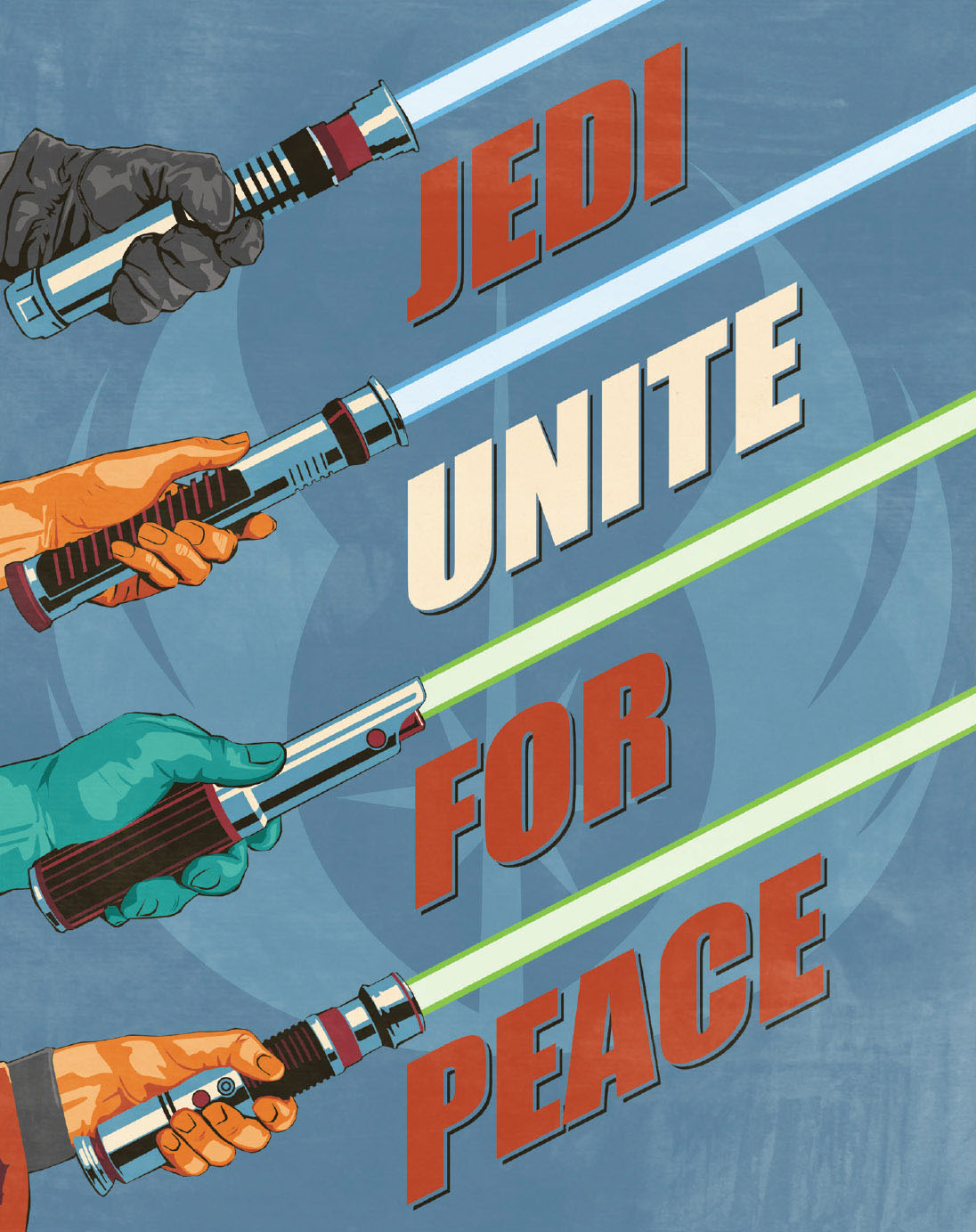
Steven Thomas
JEDI UNITE FOR PEACE
Byno Doubton, COMPOR
The back-to-back discovery of a clone army secretly commissioned by a former Jedi Master, and the Separatist Alliance ready for war, left the Jedi Order with no choice but to abandon its traditional role of negotiators and peacekeepers and to take up arms. As the Republic’s most seasoned combatants, Jedi Knights were given the rank of generals over the newly formed Grand Army of the Republic. The Jedi Council expressed its reservations about this new function, but nonetheless it was committed in its duty to the Senate. It was Chancellor Palpatine himself who recommended that images such as this poster not be used to bolster wartime support for the Republic, citing sympathy toward the Jedi discomfort. Very few examples exist of government-approved imagery that showcased the Jedi Knights in their capacity as military leaders.
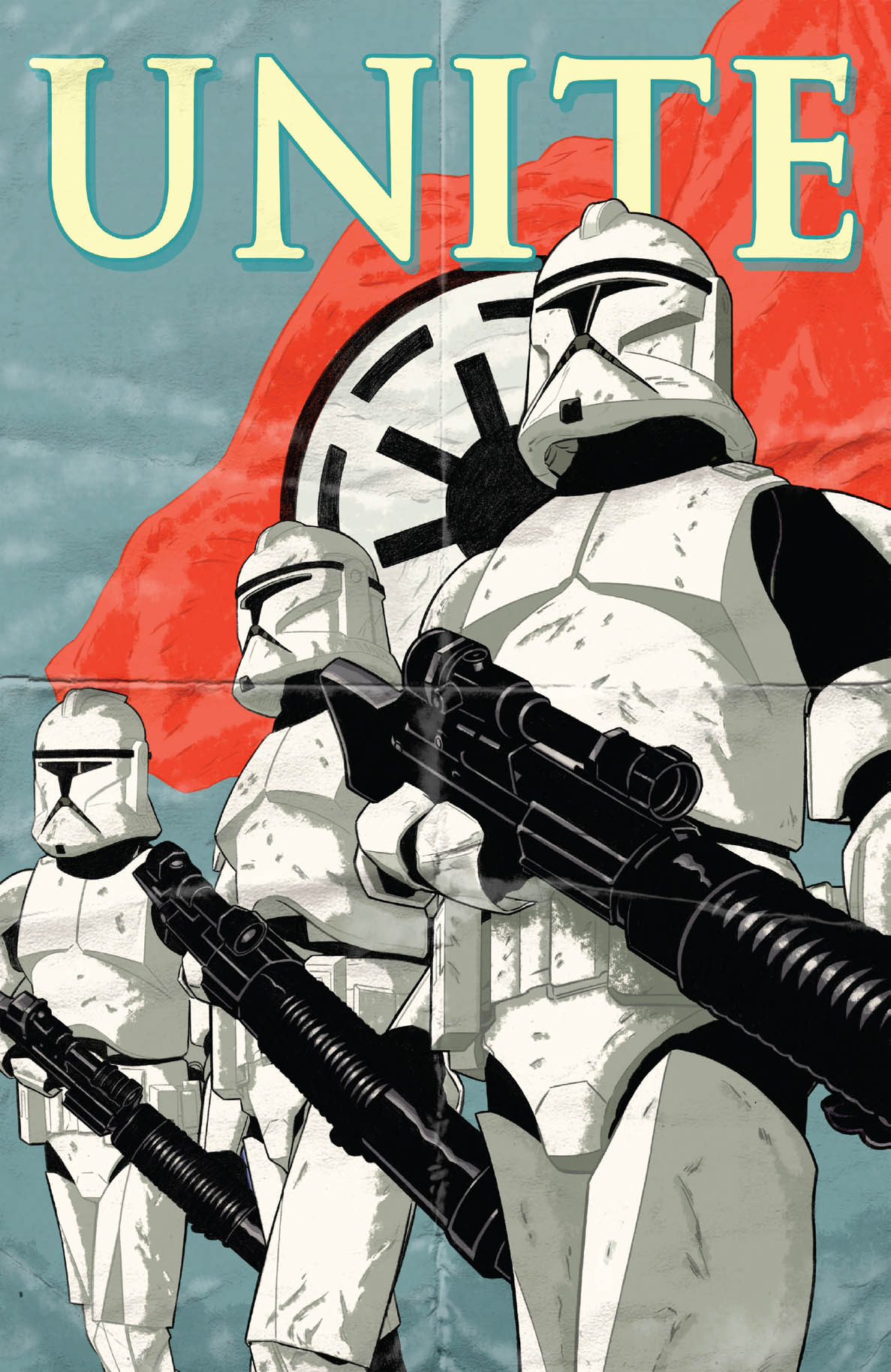
Joe Corroney
UNITE
Byno Doubton, COMPOR
The next iteration of the unity communications campaign exchanged lightsabers for clone troopers. The polished white armor of the Grand Army infantry would become the signature icon of the conflict that quickly took its name from these very ranks: the Clone Wars. The Commission for the Preservation of the Republic (COMPOR) worked closely with the newly formed Republic War Office to transform the clone trooper into the poster boy of patriotic messages across the galaxy. The ancient eight-spoked sigil of the Republic found new application on freshly minted Republic war machinery as well as on snapping flags and military banners. These were the soldiers risking all for the sanctity of the Republic and the cherished freedoms of democracy—so went the stirring messages, ballads, and holographic short subjects. Absent from these portrayals was any lingering focus on the Jedi Order.
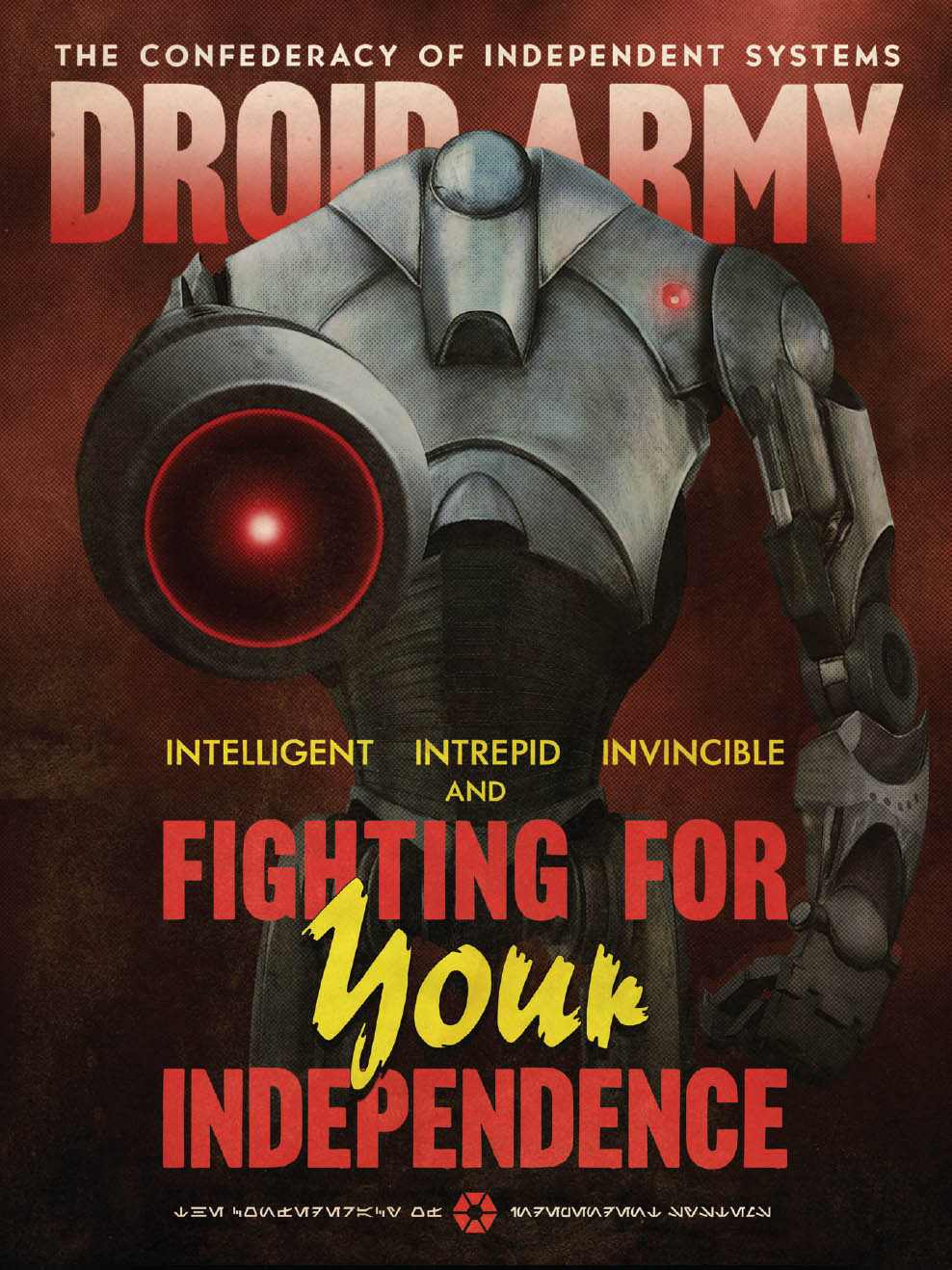
Russell Walks
FIGHTING FOR YOUR INDEPENDENCE
Q2-B3KO
The galaxy has long had an uneven relationship between organics and mechanicals. History records uprisings and clashes in ancient times as droids became increasingly commonplace in galactic society. It was the Clone Wars that cemented the “droid as an existential threat to biological life” narrative in the minds of the fearful and bigoted. Feeding on this sentiment, Republic propaganda churned out an endless barrage of terrifying images of droid-delivered destruction. In worlds aligned with the Separatist Alliance—or that neighbored Separatist territory—the tone was just the opposite. The Republic was branded as inhumane for weaponizing cloning technology to make organic soldiers, while the Confederacy of Independent Systems preserved life by relying on lifeless droids. In either scenario, the droid ended up as the voiceless party—whether casting droids as weapons of protection or offense, no side ever stopped to wonder what the droids wanted.
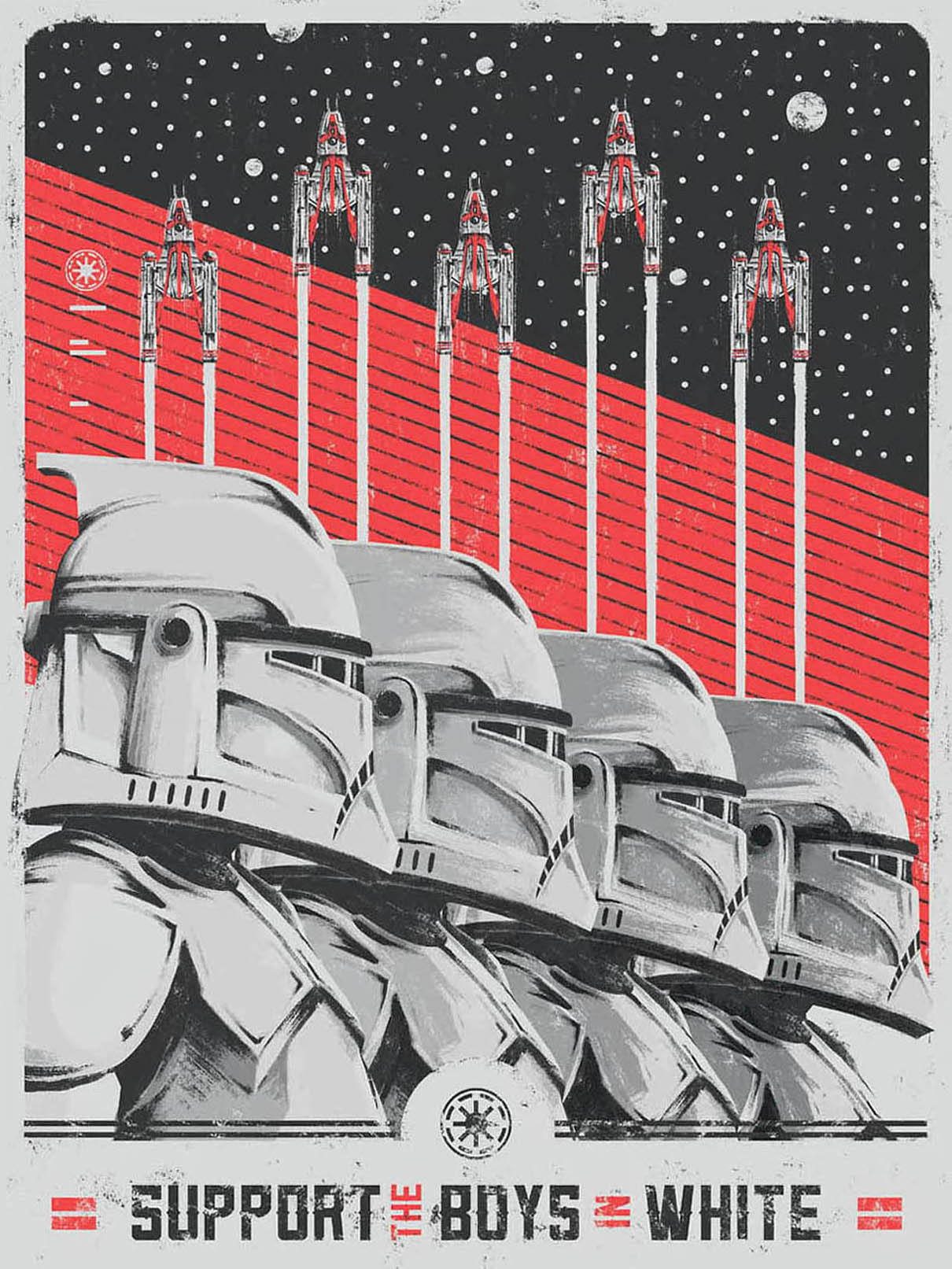
Marie Bergeron
SUPPORT THE BOYS IN WHITE
Hamma Elad, COMPOR
Early emphasis on the cutting-edge advancements of the Grand Army of the Republic came at the expense of messages based on a relatable humanity. The armored clone troopers projected strength and unity, and it was thought by some in the inner offices of Republic communications bureaus that to expose the faces behind the helmets would weaken this perception. Add to that, Separatist propaganda was describing the clone army as a biological abomination—weaponized embryos carried to artificial term, and trained since “hatching” to be expendable killing machines. The Confederacy instead considered its use of droid military “humane.” (Your author points to such confusing debates as proof of the galaxy’s inability to fully grasp the ethical implications of the rapidly expanding Clone Wars). Late in the war, attempts to humanize the clones appeared in Republic support posters, appropriating the civilian-coined nickname of “Boys in White.” As the Republic began to grow weary of the war, this name would backfire, becoming ammunition in anti-war activist dispatches, pointing to the unsettling fact that these clones were barely thirteen years old.
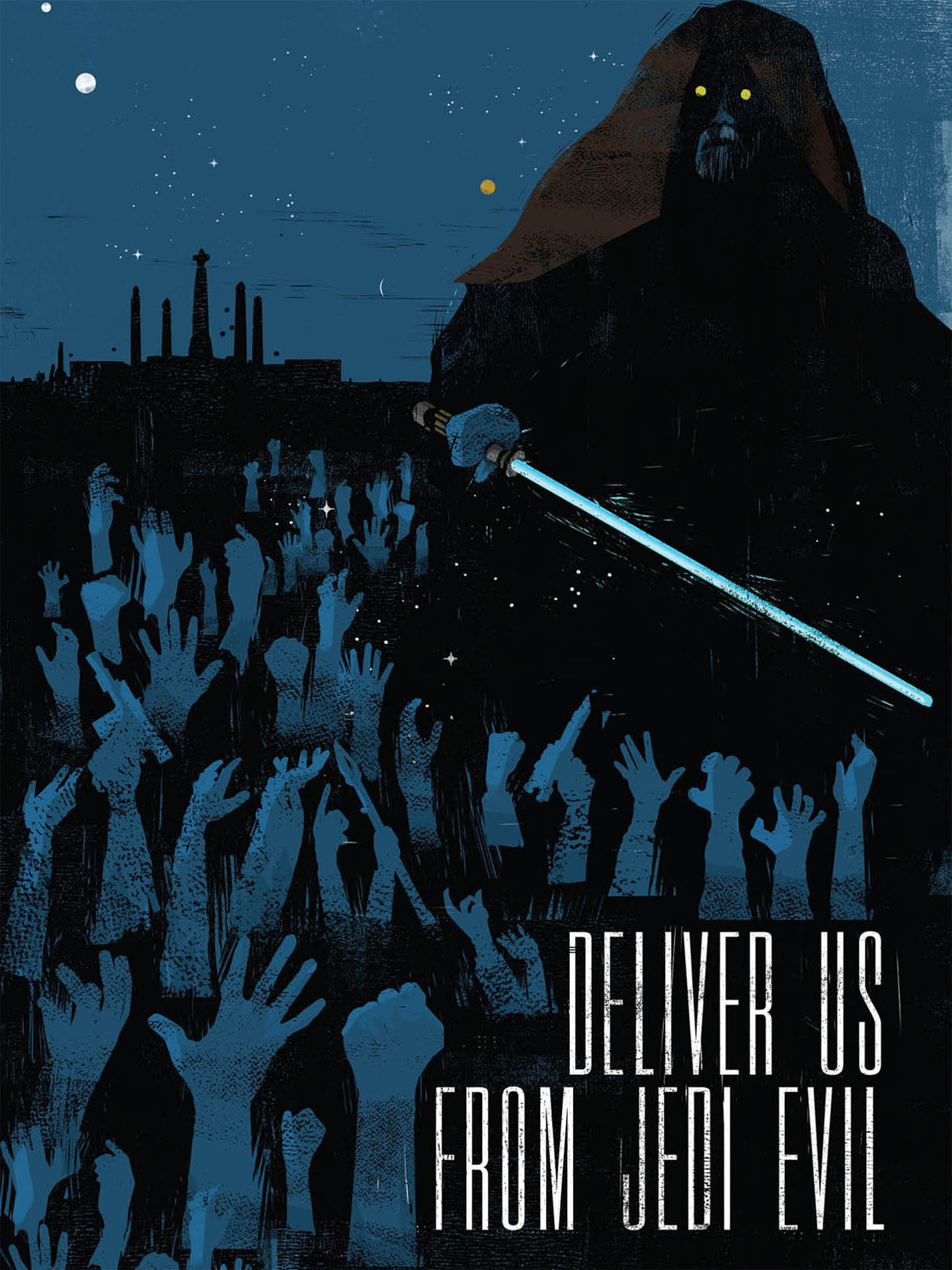
Ben McLeod
DELIVER US FROM JEDI EVIL
Moshenu Phobi
At the start of the Clone Wars, the Jedi were largely kept out of Republic propaganda, with the clone troopers becoming the face of patriotism during the conflict. This was the preference of the Order, which eschewed imagery of heroism or the romanticization of warfare. For the Separatists, however, the use of Jedi in propaganda was not so forbidden.
Anti-Jedi sentiment was more a product of their cultural absence rather than a refutation of anything substantive. Separatist worlds that had experienced lawlessness attributed that to Jedi neglect, a failure of policing. Indeed, the war itself was a failure of the peacekeepers. To these disaffected worlds, the Jedi were just one more symptom of an inattentive Core World. They imagined the Jedi to be cultural elites, or in the case of this piece, a zealous sect of warmongers.
Had the Jedi made more of an effort to engage in the populace, such deadly misunderstandings could have been avoided.
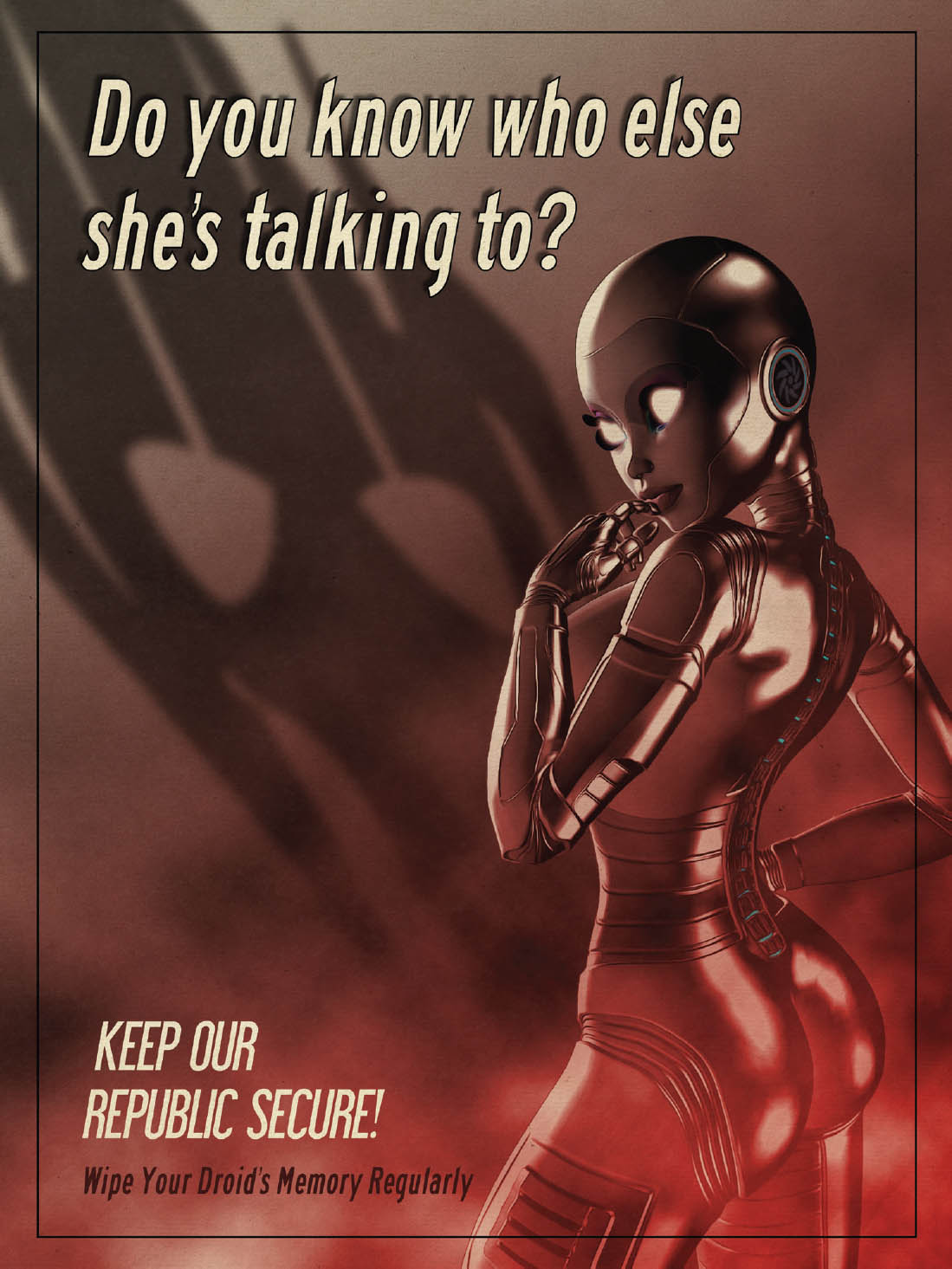
Russell Walks
KEEP OUR REPUBLIC SECURE
Yosyro Modoll
The battle droid, super battle droid, and droideka became the default images of droid terror, characterized as ruthless killing machines in Republic illustrations. In the Core Worlds, far from the front lines of the early Clone Wars, a different droid menace was dramatized in imagery targeted at affluent businessbeings and government workers. Personal assistant droids, constructed as idealizations of organic forms, were a common sight in administrative centers. The fear they had been co-opted with spyware to become mechanical eyes and ears for the Separatists was not unfounded. Borderline ribald imagery such as this piece may seem flippant at first, but the haunting silhouette of General Grievous’ battle mask is a sobering reminder of the seriousness of security.
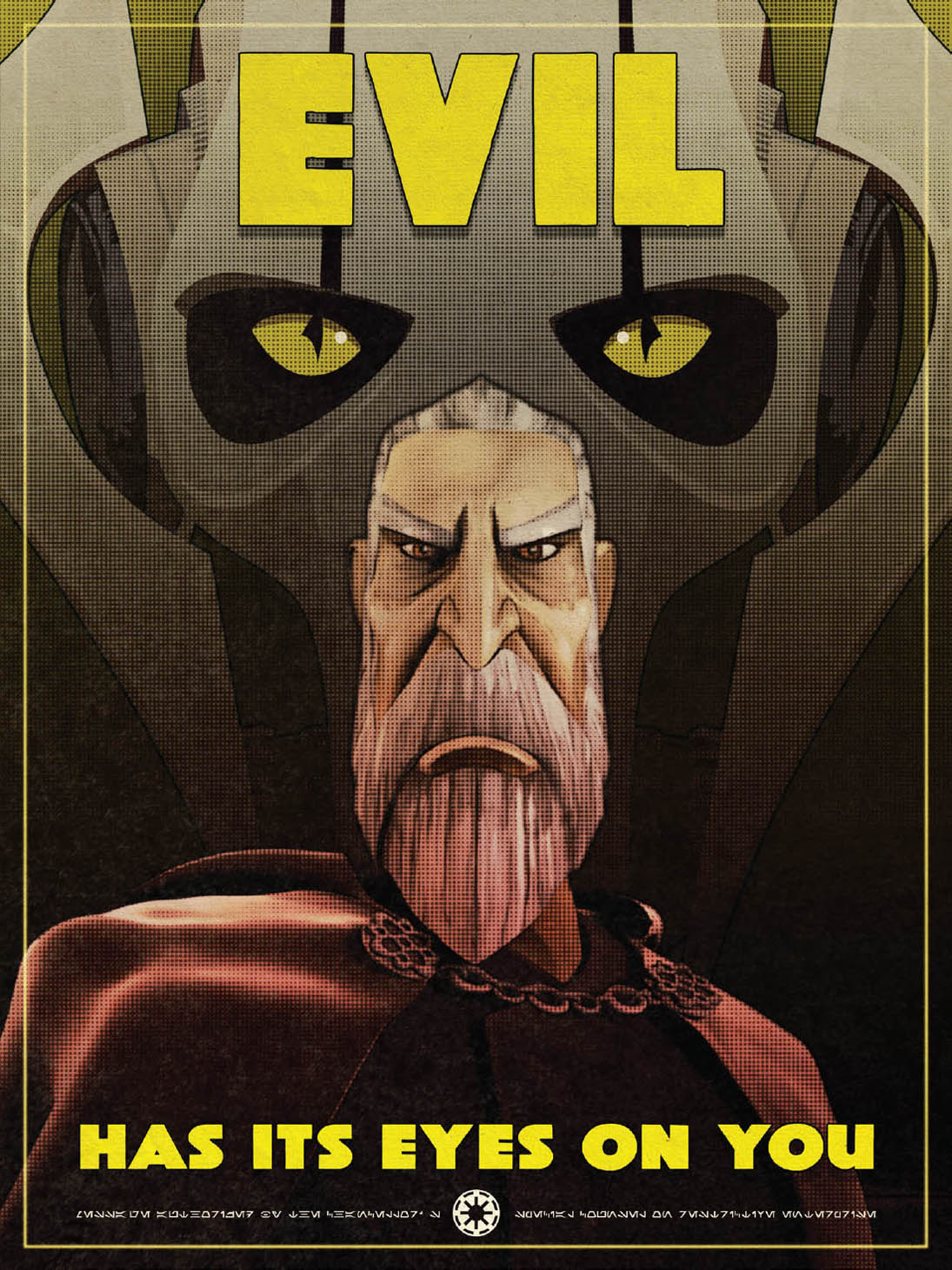
Russell Walks
EVIL HAS ITS EYES ON YOU
Donclode Onstruss
Grotesque caricatures have long been a regrettable form of propaganda message. Prior to the outbreak of the war, Count Dooku had been frequently described in media reports as “handsome,” “patrician,” or “dignified” in countenance. Once the war erupted, Republic artwork began to distort portraits of Dooku. In this image, Dooku’s features were exaggerated to appear hawk-like, or like a cutting edge sharp to the touch. The specter of General Grievous hovering behind him like some mechanical puppet master served to further strip away any shred of humanity from Dooku. Such is the nature of war; a mere decade earlier, Dooku was the subject of reverent portraiture and sculpture in the Republic, as his departure from the Jedi Order to reclaim his royal title on Serenno was a momentous occasion. But the war transformed him into a ghoul intended to haunt the citizens of the Republic.
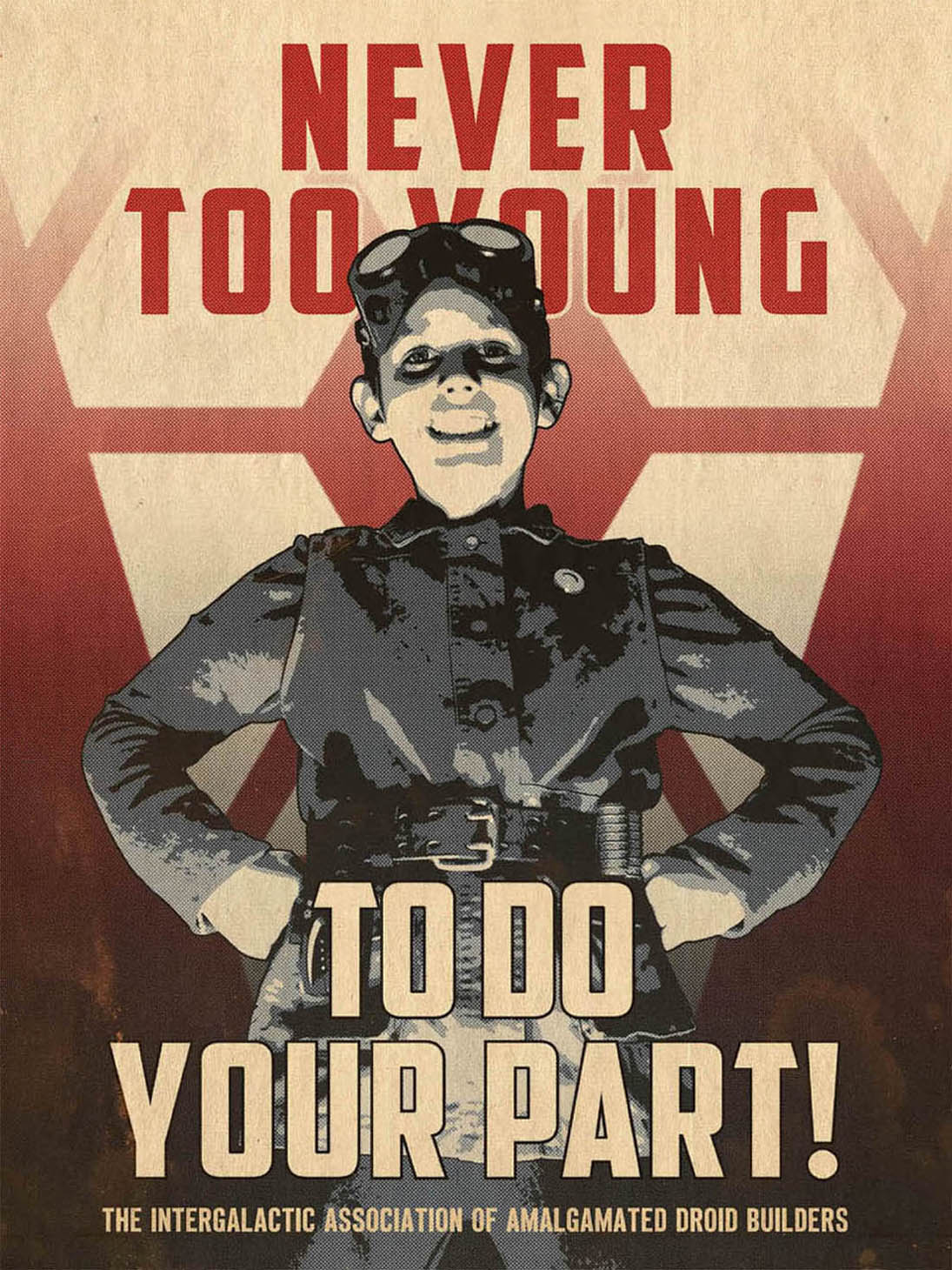
Russell Walks
DO YOUR PART!
Cosweg Budeesho
With their reliance on mechanical infantry for the bulk of their fighting forces, most Separatist worlds did not have the traditional avenue of military enlistment as an expression of patriotism. However, the battle droids did require construction and service, and Separatist-aligned technician guilds swelled with fresh talent and eagerness as beings opposed to Republic rule joined their ranks. Though much of the droid construction efforts in Separatist and unallied space was undertaken by automated assembly or Geonosian foundries, the rapidly expanding battlefront and escalating need for new soldiers made droid technician one of the most commonly held professions on many Separatist-held worlds.
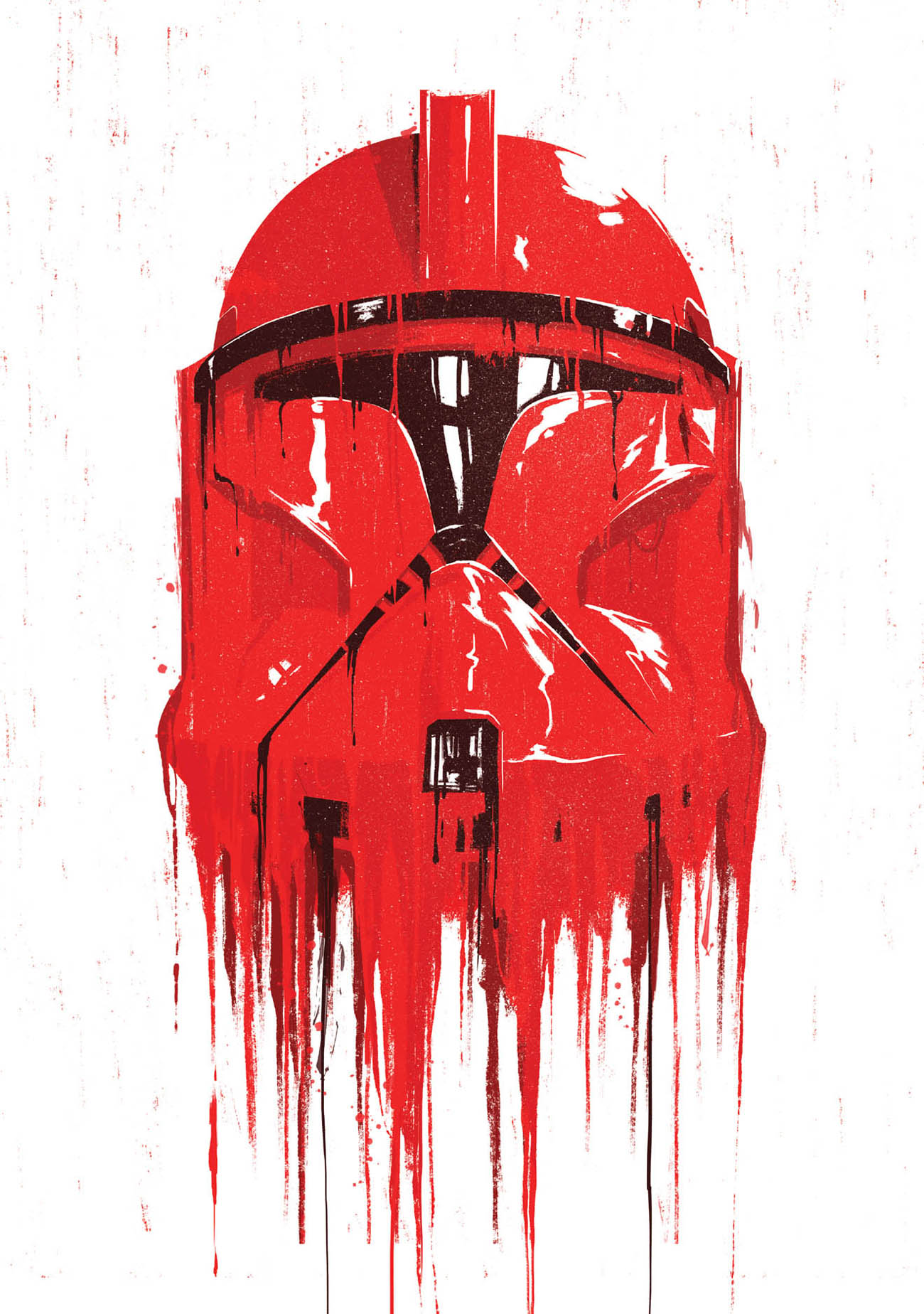
Marie Bergeron
UNTITLED
Sam Dawson
Artist Unknown
As the war slogged on month after bloody month, the citizens of the Republic grew weary of the endless conflict. A rash of underground art began surfacing on cosmopolitan worlds depicting the clone trooper not as a savior, but as death itself. The skull-like face of the Phase I clone trooper armor did a lot of the work for these disgruntled artists, who turned the boys in white into the men in blood red. COMPOR officials fretted about losing the narrative of the brave clone troopers in the hearts and minds of the citizenry. In addition to the violence, the Republic was being bankrupted by the war effort—many essential services were cut off in the name of wartime sacrifice. Had the war not turned during the Outer Rim Sieges, it’s possible support for the war effort or confidence in Chancellor Palpatine’s leadership may have permanently eroded.
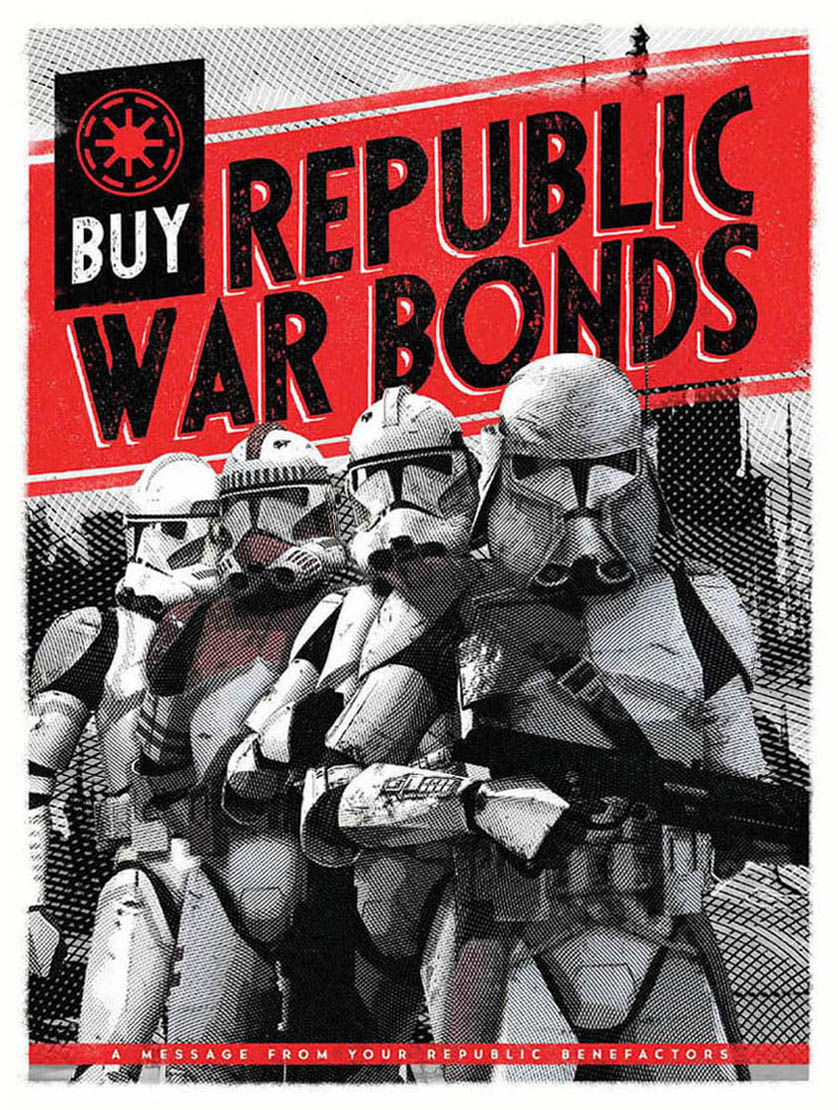
BUY REPUBLIC WAR BONDS
Janyor of Bith
The work of a young graduate of the Cadomai Art Institute enraptured by patriotic fervor, this piece glamorizes the sleek and effective armor of the Grand Army of the Republic. No humanity shines through any crack in the combat gear of these modern soldiers, for to show flesh is to show weakness in the face of a mechanized enemy. The clone soldier became a symbol more powerful than the mortal men beneath the masks. Without using words to express it explicitly, the design of this image suggests that such cutting-edge war technology comes at a price. To the Republic citizens asked to make sacrifices, there was no doubt where their contributions were going: they were funding security in the form of military might.
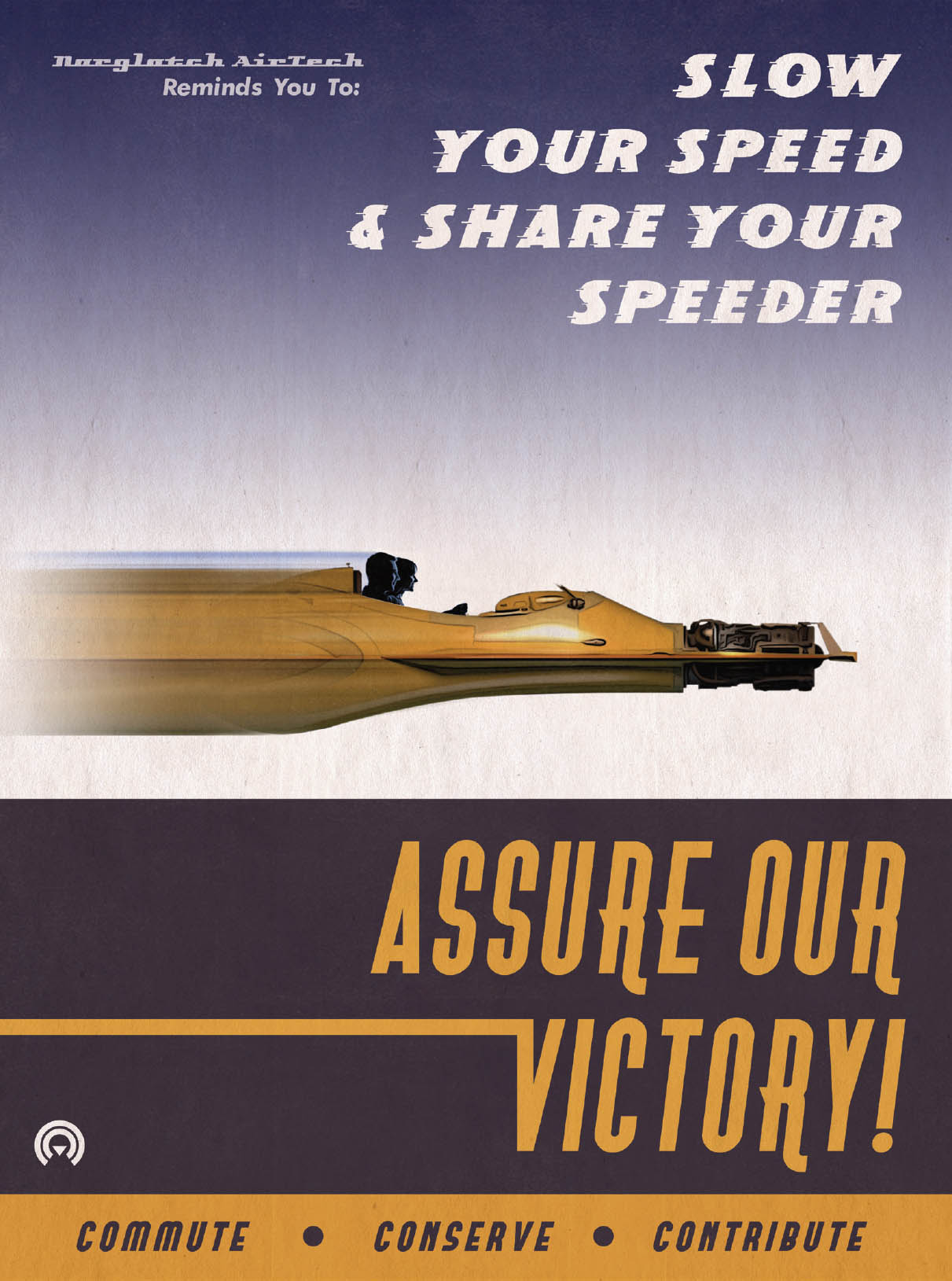
Russell Walks
ASSURE OUR VICTORY!
Simeon Densend, Narglatch AirTech Art Department
Expressions of patriotism and civic duty on Republic worlds faced some of the same limitations as those on Confederacy ones. There was no army to join—the Grand Army’s ranks were exclusively clone-based. Still, the Republic faithful wished to do their part. A successful war bond program helped fill the Republic war chest, and citizens were asked to make sacrifices. This extended to energy expenditures in such mundane tasks as driving. In the name of rationing, as well as security, civilian skylanes were limited to multi-passenger vessels traveling at specific speed limits. On cosmopolitan worlds like Coruscant, this was an unprecedented sacrifice. For those not able to curb the pace of their modern lifestyle, the fast lane was set aside and accessible only to those willing to pay higher taxes.
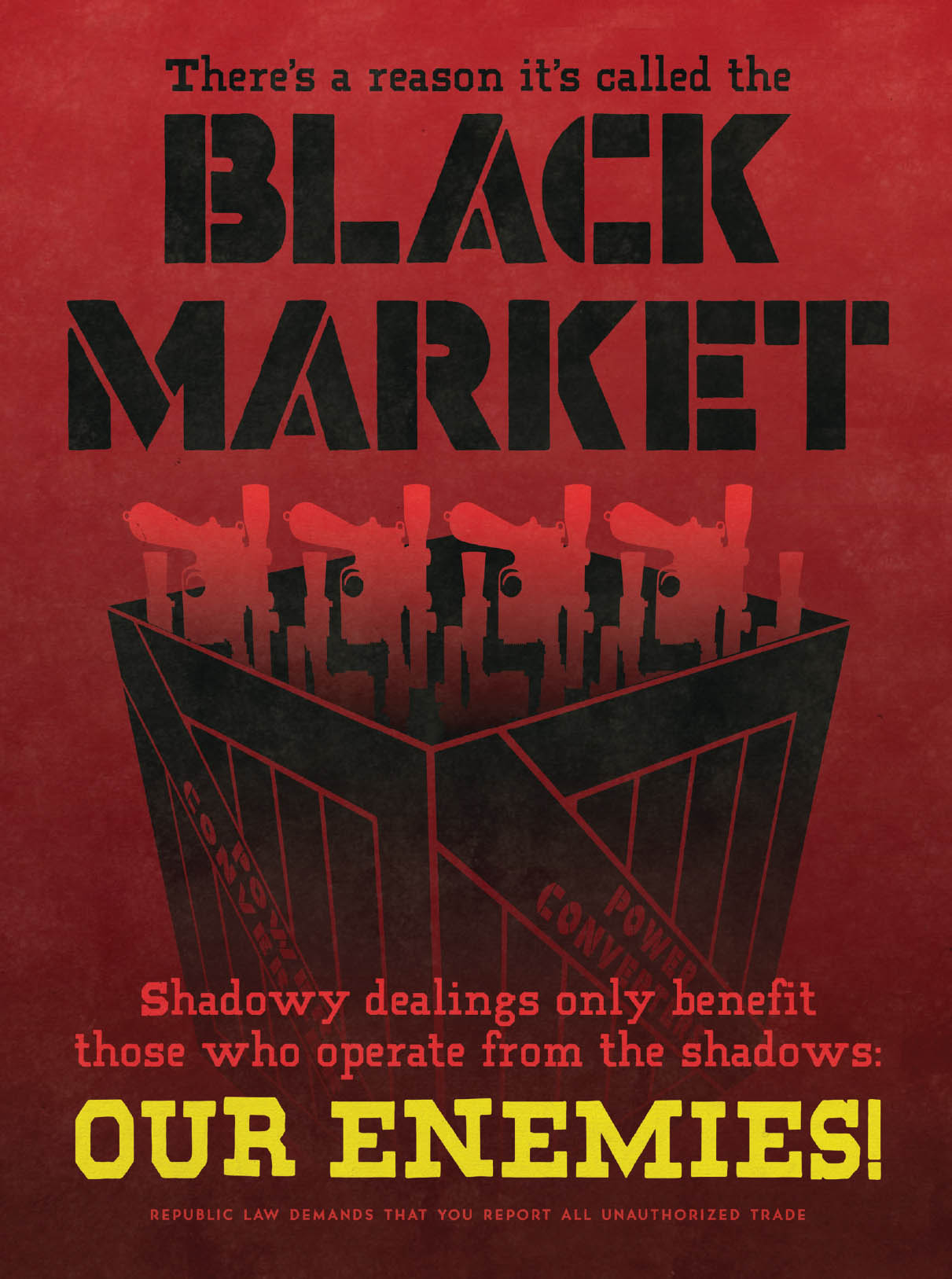
Russell Walks
BLACK MARKET
Artist Unknown
Increasing demands of the Republic war effort led to shortages in the heart of the Republic, and a society that had grown used to its luxuries now found itself stripped of many essential services. In a bid to secure their borders, many Republic sectors severely limited ports of access. And in this particular ecology of supply and demand, the lifeblood of money and goods finds a way to flow and even things out. Black markets prospered throughout the Republic, despite the best efforts of policing agencies and clone interdiction forces. Addressing such want as irresponsible was a common theme in messages designed to counter the appeal of the black market. Underlining these messages was the moral that helping yourself in this way was helping the enemy, and hurting the war effort.
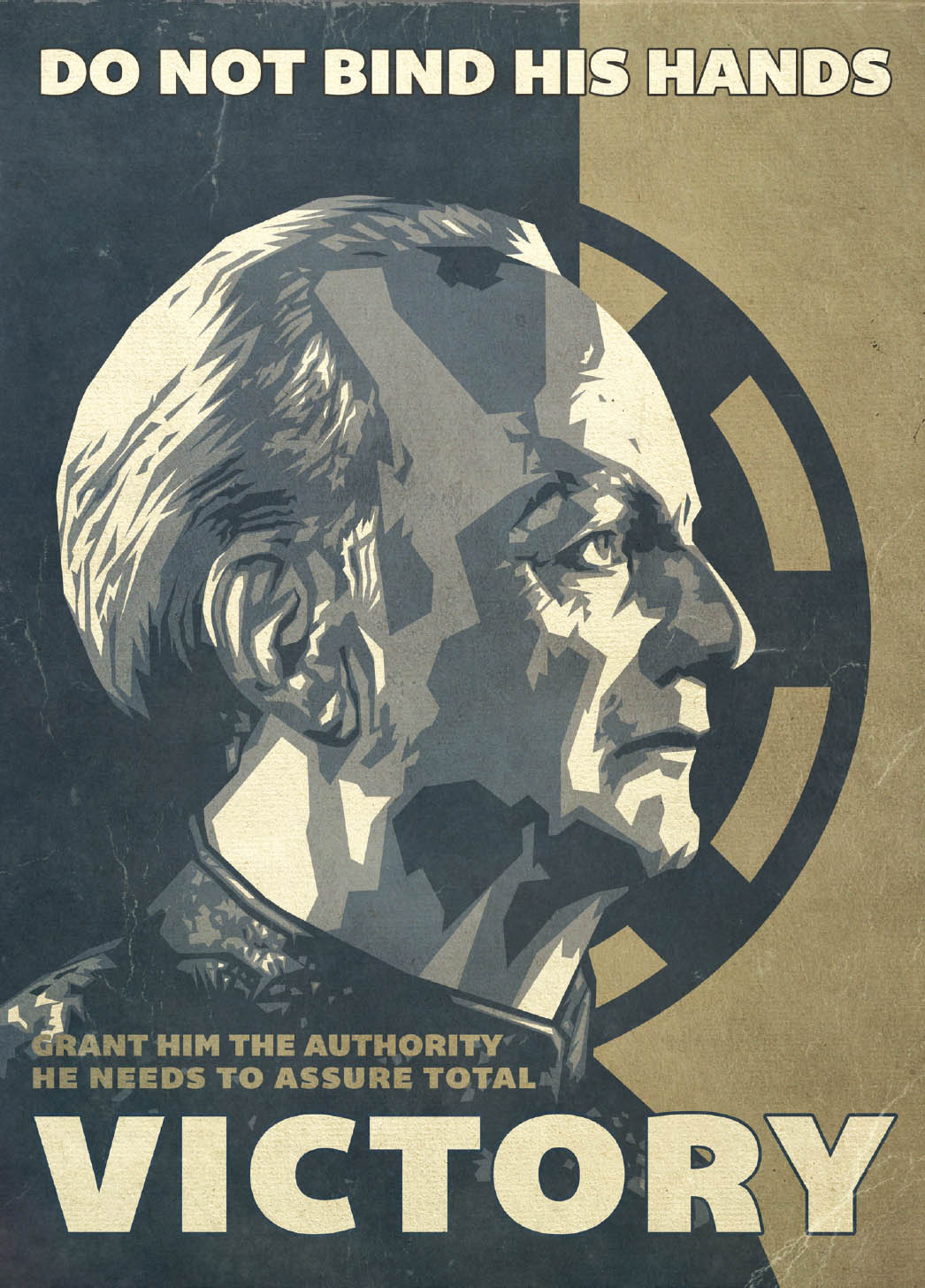
Russell Walks
DO NOT BIND HIS HANDS
Venthan Chassu
A shrewd politician, Sheev Palpatine of Naboo was able to maintain the image of a modest Mid Rim senator combating a corrupt and complacent institution despite accruing great authority over that institution. His rise to power was always tempered by a carefully crafted reluctance—his ascent, after all, came about from outpourings of sympathy for his defenseless planet bullied into subjugation by the Trade Federation. He again voiced regret and trepidation at amending the constitution to allow him to extend his term in office, but felt it was needed for the good of the Republic in the face of the Separatist crisis. Palpatine played the role of the beleaguered pragmatist—cutting through well-intentioned checks and balances in the face of extraordinary crisis, making the hard, hand-wringing choices because it was his duty and his destiny. The public loved him for it.
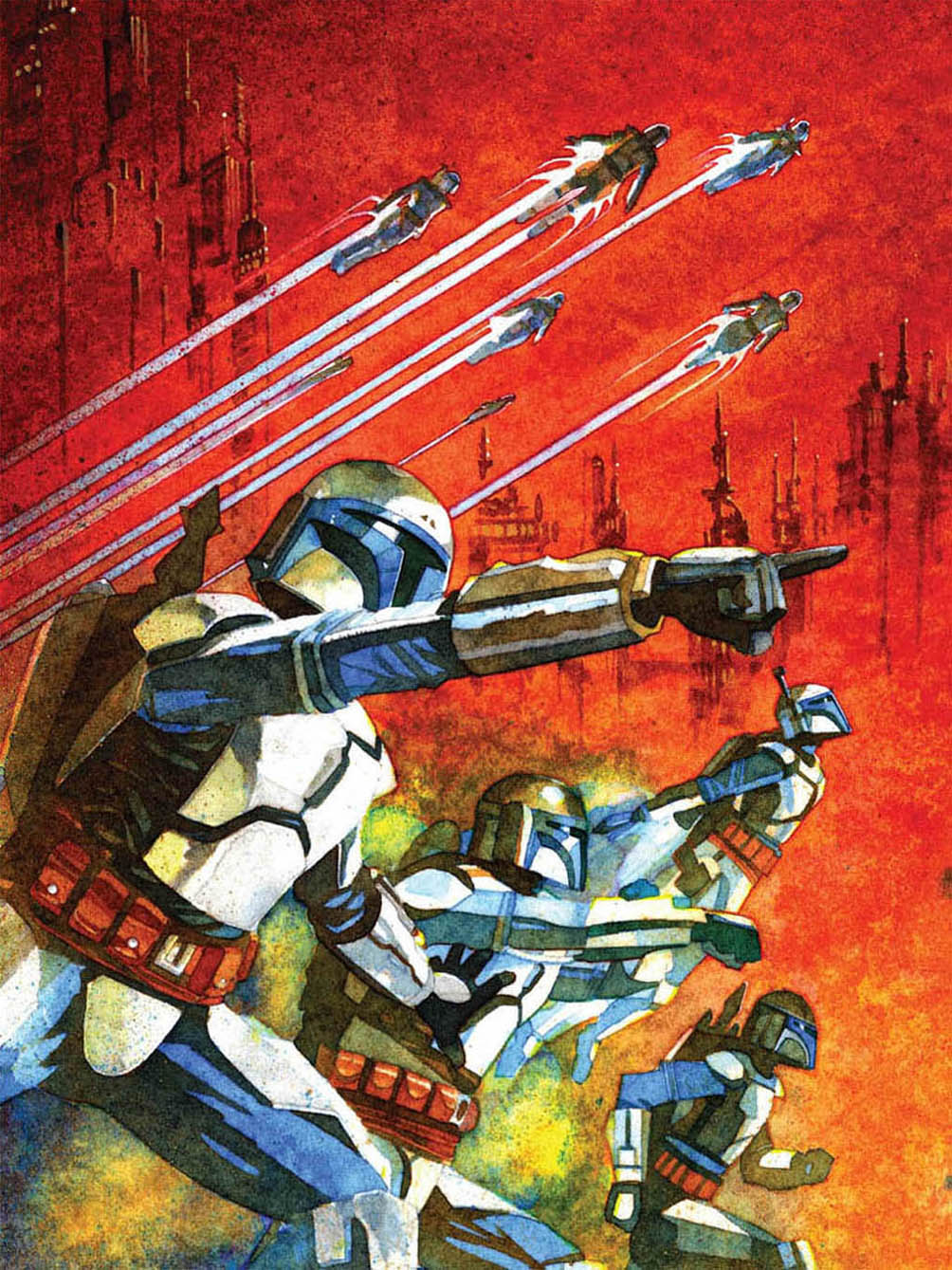
Mark McHaley
UNTITLED DEATH WATCH PIECE
Veraslayn Kast
The chaos of the Clone Wars inflamed old wounds that had supposedly healed with the passage of time. The independent world of Mandalore is an iconic example of how a planet steadfastly neutral in the conflict between the Republic and the Separatists could nevertheless be radically transformed by the war. Local conflicts between the many Mandalorian clans led to the rise of a New Mandalorian pacifist movement, and for many years, the planet was at peace as it rebuilt in wake of planet-devastating warfare. In the shadows of these efforts, a terrorist splinter group known as the Death Watch was gearing up for an attempted coup. On Mandalorian worlds, recruitment images rendered in the cubist Mandalorian style were secretly distributed at gatherings of anti-pacifism sympathizers. On worlds far from Mandalore, expats were stirred by more realistic renderings of armored Death Watch supercommandos in action—the first time any such warriors were depicted in battle in ages.
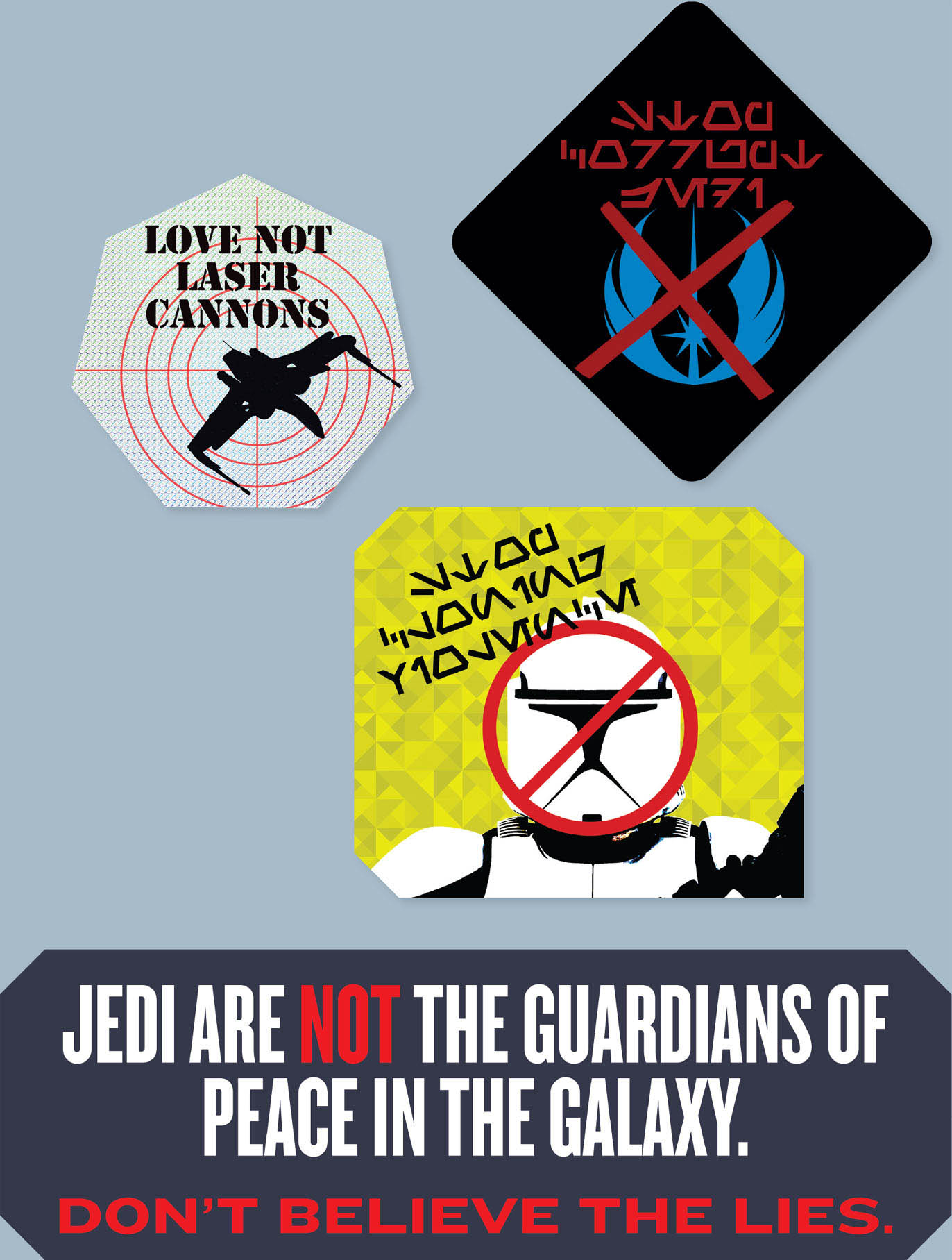
Rosanna Brockley

Rosanna Brockley
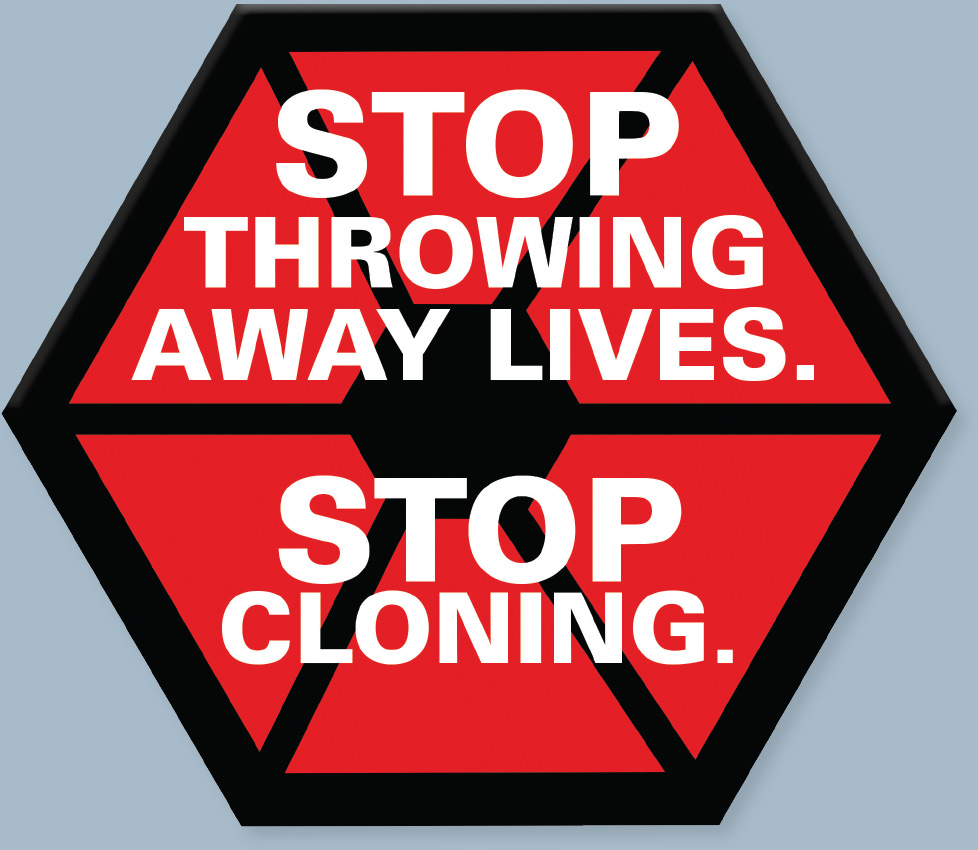
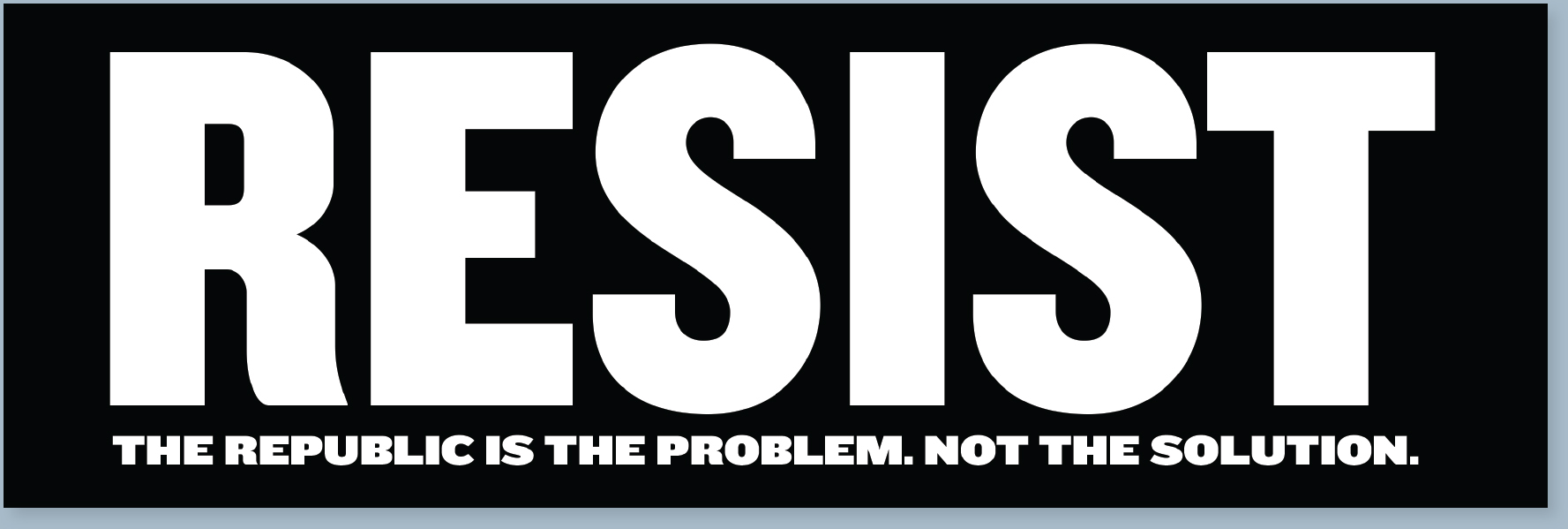
ASSORTED CHASSISPLASTS
Various Artists
The Clone Wars created a spike in self-published political expression, so much so that in some cases it became impossible to determine which messages were being crafted by government bodies and which were the result of impassioned citizens amplifying or originating their own. It was with no small alarm that the government bureaus of Coruscant saw how quickly propaganda not within their control spread.
A quick, cheap-to-produce form of self-publishing was the chassisplasts, small, colorful adhesives that easily affixed to most surfaces. On speeder-congested worlds like Coruscant, stickers on speeder fairings became the most popular form of political discourse for commuters. A special division of COMPOR was appended to the Coruscant Traffic Violation Bureau to scan holographic records of speeders to account for and track particularly troublesome expressions of anti-Republic messages.